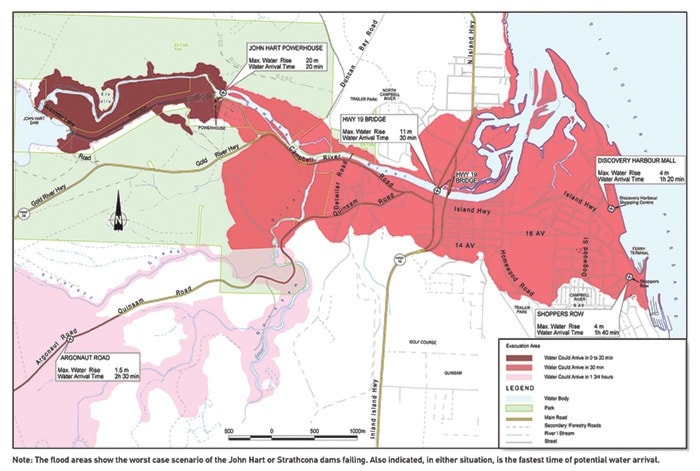When – not if – “The Big One” hits, Strathcona Regional District (SRD) protective services coordinator Shaun Koopman’s house and office is ready for it.
And he wants everyone else’s to be, too.
Koopman and BC Hydro spokesperson Stephen Watson are reminding the community that there are significant risks associated with living in this beautiful part of the world. Despite the region’s beauty, there is something terrifying lurking just under the surface.
The Cascadia Subduction Zone is a major fault line running from northern Vancouver Island down to northern California, and it’s packing enough power to do serious damage if it releases it.
For people who remember the video footage from the San Francisco earthquake in 1989, where the bridges were swaying and the ground was literally ripping open and swallowing people, cars and buildings, Watson says, that’s nothing compared to what could happen here.
“The Cascadia Subduction Zone is much stronger than the San Andreas Fault,” he says. “A major seismic event here could be the biggest ever recorded in North America. It would be on a whole other level.”
“In terms of energy,” Koopman says, “think about 60,000 Hiroshima bombs going off at once.”
So what’s going to happen when the fault releases that energy?
In 2014 BC Hydro did a seismic study analysis, “to figure out what the ground motions would be in a major earthquake,” Watson says, “and the bottom line is that these (dam) facilities were built in the 40s and 50s.” Seismic guidelines back then weren’t what they are today, he says, and while while the three dams in the Campbell River water system – the Strathcona, the Ladore and the John Hart – are in better shape seismically than they were when they were built, thanks to upgrades that have happened over the years, there is still a risk that during a major quake, one or more of them could give way, inundating downtown and low-lying areas with water, “and it could arrive within about an hour.”
Watson says they have “a solid plan” in place to upgrade those dams, “but that’s happening over the next 20-odd years, so until that is done, if we get that major earthquake, there is that risk. We have to plan and be ready for the worst case scenario.”
Hydro, along with the city and the SRD, put on a series of workshops and information sessions to share the results of those studies at the time they were completed, but he says it’s time to remind people of their findings.
“It’s been almost two years since we did that,” Watson says, “and with the Great Shakeout coming up, it’s a good opportunity to remind people about having a plan and being prepared.”
The Great ShakeOut happens on the third Thursday of October each year at 10:20 a.m. This year that’s Oct. 20.
“We ask people to, at the very least, drop, cover and hold on,” Koopman says. “And then we ask people to think about things like how you would reunite with your family after? Have you secured building fixtures? Do you know what to do? Have you safeguarded your finances?
“We just ask people to be really earthquake conscious on at least this one day.”
People or businesses who choose to participate are encouraged to register at ShakeOutBC.ca so they can keep track of how many people participate. ShakeOutBC says over 770,000 people participated last year.
And Koopman wants people, whether they participate in the ShakeOut or not, to at least discuss their preparedness levels with their friends and family, because talking about it keeps it “front of mind.”
“The number one thing that influences others is the actions of those they care about,” Koopman says. “If you do have a grab and go bag, share what you have done with the people in your life. Talk about your preparedness levels with your friends. That’s what gets people going on this stuff.”
And take the time to look around you before it all goes down.
“We can’t do anything to stop the earthquake from happening, but how much damage it causes to you, in your household, is your personal choice, because there’s a lot you can do to mitigate your personal risk,” Koopman says. “Ninety-five per cent of earthquake deaths and injuries are caused by objects flying around – the TV coming off its mount and hitting someone in the face or the bookshelf coming down and crushing someone.”
Fortis is also encouraging people to be prepared.
“In addition to preparing and protecting yourself … we want to share important tips on how to secure your natural gas and electrical appliances before and after an earthquake,” says Fortis spokesperson Amy Bunton.
Fortis has created a website as well as a video providing tips for the public and is also encouraging participation in the ShakeOut next Thursday.
Here's the Household Emergency Plan document (PDF) people should fill out and keep with their emergency kits.
